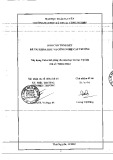
This Provisional PDF corresponds to the article as it appeared upon acceptance. Fully formatted
PDF and full text (HTML) versions will be made available soon.
Fair, efficient, and power-optimized spectrum sharing scheme for cognitive radio
networks
EURASIP Journal on Wireless Communications and Networking 2011,
2011:201 doi:10.1186/1687-1499-2011-201
Saleem Aslam (saleem83@nrl.sejong.ac.kr)
Kyung Geun Lee (kglee@sejong.ac.kr)
ISSN 1687-1499
Article type Research
Submission date 15 July 2011
Acceptance date 13 December 2011
Publication date 13 December 2011
Article URL http://jwcn.eurasipjournals.com/content/2011/1/201
This peer-reviewed article was published immediately upon acceptance. It can be downloaded,
printed and distributed freely for any purposes (see copyright notice below).
For information about publishing your research in EURASIP WCN go to
http://jwcn.eurasipjournals.com/authors/instructions/
For information about other SpringerOpen publications go to
http://www.springeropen.com
EURASIP Journal on Wireless
Communications and
Networking
© 2011 Aslam and Lee ; licensee Springer.
This is an open access article distributed under the terms of the Creative Commons Attribution License (http://creativecommons.org/licenses/by/2.0),
which permits unrestricted use, distribution, and reproduction in any medium, provided the original work is properly cited.

Fair, efficient, and power-optimized spectrum sharing scheme for
cognitive radio networks
Saleem Aslam and Kyung Geun Lee*
Department of Information and Communication Engineering, Sejong
University, Seoul, Republic of Korea
*Corresponding author: kglee@sejong.ac.kr
Email address:
SA: saleem83@nrl.sejong.ac.kr
Abstract
The cognitive radio network (CRN) is a promising solution to the problem
of spectrum scarcity. To achieve efficient spectrum utilization, cognitive
radio requires a robust spectrum sensing and spectrum sharing scheme.
Therefore, spectrum sharing scheme plays a key role in achieving the
optimal utilization of the available spectrum. The spectrum sharing in CRN
is more challenging than traditional wireless network. The main factors
besides throughput and fairness which need to be addressed in spectrum
sharing of CRN are primary user (PU) activity, transmission power, and

variations in the radio environment. In this article, we propose fair, efficient,
and power-optimized (FEPO) spectrum sharing scheme that will incorporate
all critical factors mentioned above to maximize the spectrum utilization.
Simulation results show that FEPO scheme outperforms in terms of
transmission power by reducing the number of retransmissions and
guarantees required level of throughput and fairness. Moreover, periodic
monitoring helps to reduce the number of collisions with PUs.
Keywords: cognitive radio; spectrum sharing; primary user arrival activity;
licensed user; FEPO.
1. Introduction
Current static spectrum management schemes allocate fixed spectrum to
each existing wireless network. These schemes assign a block of the
spectrum band to a particular radio access-network standard, which is further
divided for spectrum allocations into individual operators of this access
technology. However, in recent years, wireless network technology grows
exponentially especially in the domain of low-cost wireless applications that
utilize the unlicensed spectrum bands. These growing applications have
raised the issue of spectrum scarcity for upcoming wireless services and

stirred the researchers to find new techniques for the efficient utilization of
the available spectrum. On the other side of the picture, the Federal
Communication Commission has reported that existing spectrum utilization
is very sparse at any given time and space [1, 2] as shown in Figure 1a.
It shows the variations in power spectral density (PSD) across the radio
spectrum from 0 to 6 GHz. Although there is a dense spectrum utilization
from 0 to 2 GHz yet there is a very sporadic spectrum utilization between 3
and 6 GHz. To deal with the problem of the inefficient spectrum utilization,
a new concept is evolved called dynamic spectrum access (DSA) or
opportunistic spectrum sharing (OSS) [1–3]. The DSA employs cognitive
radio (CR), a potential technology to reform the mechanism of spectrum
utilization. The DSA architecture consists of two main entities: licensed user
(LU) or primary user (PU), which has the legal rights to use the spectrum
and CR user or secondary user (SU); CR has temporal rights to utilize the
spectrum band of PUs on a negotiation basis. For example, in Figure 1b,
there are five PUs and four SUs operating in a cell with single active PU at a
given instant.
To avoid harmful interference with PU and to maximize efficiency of the
spectrum utilization, CR should periodically sense the radio environment

and opportunistically accesses the spectrum hole by dynamically adjusting
its transmission parameters like power level, modulation scheme, and coding
scheme. There are four major stages of the CR: (1) spectrum sensing, (2)
spectrum management, (3) spectrum sharing, and (4) spectrum mobility [3].
The prime objective of CR is the reliable detection and the optimal sharing
of spectrum holes among CR users.
Sharing schemes provides a way for spectrum allocation and multiplexing at
the data packet level. Moreover, congestion and admission control
mechanisms are directly dependent on sharing schemes. Many sharing
schemes capable of ensuring required level of QoS in wireless networks
have been proposed in the literature. However, these schemes cannot be
directly applied to cognitive radio network (CRN) because of the variation in
the capacity and quality of wireless channels across space and time and PU
arrival activity. Currently, it is an urgent need to develop new spectrum
sharing schemes at medium access control (MAC) layer for providing
required level of QoS and operate under tolerable interference limit.
Moreover, it is also desirable that the sharing scheme keeps track of the
changes occur in the condition and capacity of available wireless channels.
Among all other technical issues need to be addressed, spectrum sharing is
one of the important issue. In this article, we propose a robust spectrum


























